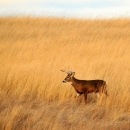Seasons of Wildlife
January to April
Wintering waterfowl, including tundra swans, have typically departed Eastern Neck National Wildlife Refuge by the end of March. Bald eagles are nest building in January and laying eggs through February. Although most of the nests are in areas not visible to the public, they can sometimes be seen displaying courtship behaviors as pairs, or carrying nesting material into the forests near the marshes. The eaglets begin hatching in April, and busy parents can sometimes be seen carrying food to the nests.
Woodcock may be seen performing their courtship displays along some trails, such as Duck Inn, near sunset on early spring evenings. Their eggs begin hatching in April. Osprey begin to appear back in the area around St. Patrick's Day in March, following their migratory return from South America. Blue- and green-winged teal migrate through the area in April, and resident ducks begin incubating their eggs at this time. As May approaches, migratory songbirds begin to increase in numbers as they make their return trip north for the breeding season.
May to August
Songbird migration northward peaks in late April to early May. Duck Inn Trail is one of the best trails on the refuge to look for migratory warblers, thrushes, kinglets, and more. Deer fawns are born in late May and fawns encountered in the woods and fields after that time are not orphaned, but are hiding from predators. Their mother will return for them soon.
Look for osprey nests on platforms situated atop utility poles around the refuge. Their eggs also hatch in late May. Barn swallows return to their nests under the roof of the porch at the refuge office, and bluebirds and tree swallows establish territories at bluebird nesting boxes around the refuge. Throughout June, breeding bird species can be heard singing throughout the refuge, along trails and roads.
In June, young eagles are learning to fly and will fledge from the nest in July. Throughout the summer, the barn swallows at the refuge office provide a close-up look of nesting birds for visitors.
Butterfly numbers and diversity reach their peak on the refuge in July. The native plants in the BayScape garden at the refuge office and along the BayView Butterfly Trail attract these winged beauties in high numbers. Zebra swallowtails, black swallowtails, and American ladies are among the more common species. The water garden in the BayScape will be "hopping" with leopard frogs.
In August, ospreys may start their migration south while blue-winged teal, the earliest waterfowl migrants, being to arrive from their northern breeding grounds.
September to December
Songbird migration southward peaks in late September to October.
Waterfowl numbers gradually increase as many species make their journeys south from their northern breeding grounds. By mid- to late-November, and sometimes earlier, tundra swans begin to arrive at the refuge. Sometimes large staging groups will arrive at once, and sometimes smaller groups will arrive more gradually.
Bald eagles begin to establish territories and start nest building in December.
Featured Species
Depending on when you visit, there is a wide variety of wildlife to see at Eastern Neck NWR. Each season has its own special reason to visit - whether it's swans or butterflies or eagles! Typically, most wildlife are more active in the morning and evening, and less active during the middle of the day. This is especially true of birds and other wildlife during the warm months of spring and summer. Plan to bring your binoculars, your field guides, your camera, and plenty of patience. And, if it is summer, you might want to pack the insect repellent as well!




